Passengers 136 Survivors 152 (all) Number of deaths 0 Crew count 16 | Fatalities 0 Date 17 January 2008 Destination Heathrow Airport Passenger count 136 | |
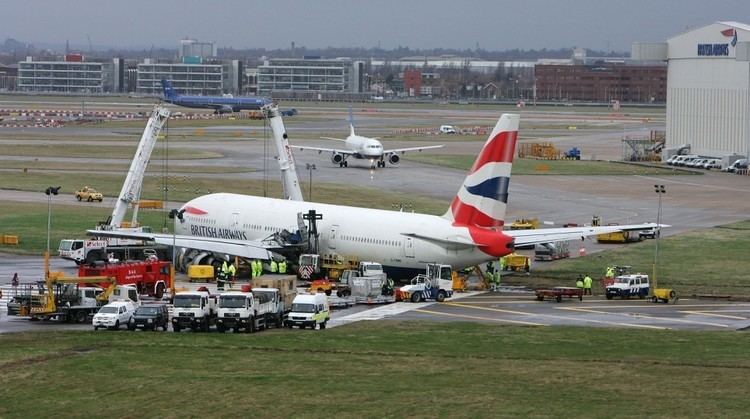 | ||
Injuries (non-fatal) 47 (including 1 serious) Similar British Airways Flight 5390, British Airways Flight 9, Crossair Flight 3597, Air France Flight 358, British Airtours Flight 28M | ||
Fs2004 heathrow enigma british airways flight 38
British Airways Flight 38 (call sign Speedbird 38) is a scheduled flight operated by British Airways from Beijing, China to London, United Kingdom. On 17 January 2008, local time 12:32 GMT, the Boeing 777 used for the flight, having completed the 8,100-kilometre (4,400 nmi; 5,000 mi) trip, crashed just short of the runway at its destination. There were no fatalities but from the 152 people on board, 47 people sustained injuries, one of them serious. The 150-tonne aircraft was the first Boeing 777-200ER to be written off in the model's history, and the first hull loss of any Boeing 777.
Contents
- Fs2004 heathrow enigma british airways flight 38
- British airways flight 38 heathrow crash atc recording
- Accident
- Aftermath
- Initial speculations
- Investigation
- Special Bulletin 18 February 2008
- Special Bulletin 12 May 2008
- Interim Report 4 September 2008
- Final report 9 February 2010
- Similar incidents
- Lawsuit
- Dramatisation
- References
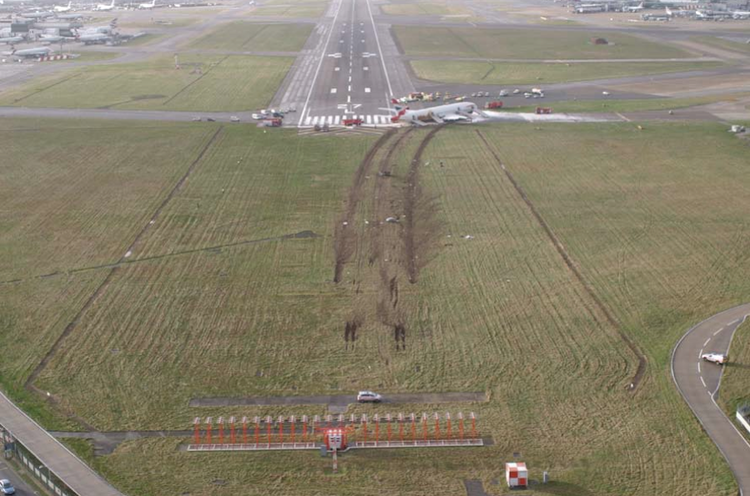
Ice crystals in the fuel were blamed as the cause of the accident, clogging the fuel-oil heat exchanger (FOHE) of each engine. This restricted fuel flow to the engines when thrust was demanded during the final approach to Heathrow. Boeing identified the problem as specific to the Rolls-Royce engine fuel-oil heat exchangers, and Rolls-Royce subsequently developed a modification to its FOHE; the European Aviation Safety Agency (EASA) mandated that all affected aircraft were to be fitted with the modification before 1 January 2011.
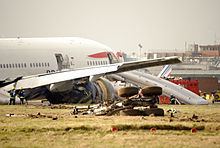
British airways flight 38 heathrow crash atc recording
Accident
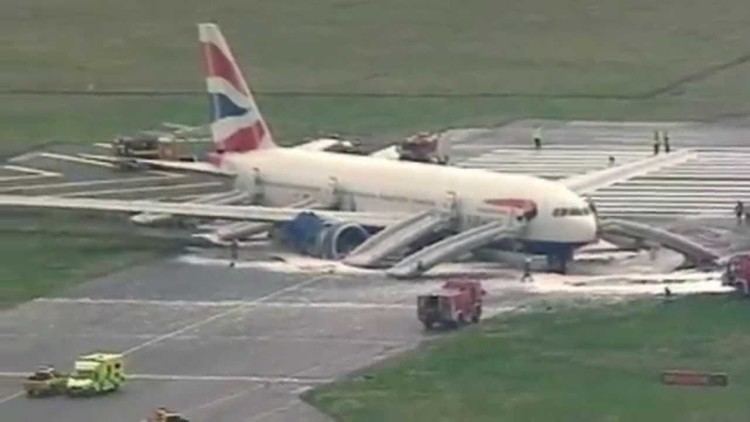
The aircraft used for the flight was Boeing 777-236ER G-YMMM (manufacturer's serial number 30314, line number 342), powered by two Rolls-Royce Trent 895-17 engines. The aircraft first flew on 18 May 2001 and was delivered to British Airways on 31 May 2001. It had a seating capacity for 233 passengers.

Flight 38's route took it over Mongolia, Siberia and Scandinavia, at an altitude which varied between 34,800 and 40,000 ft (FL348–400, between 10,600 and 12,200 m), and in temperatures between −65 and −74 °C. Aware of the cold conditions outside, the crew monitored the temperature of the fuel, with the intention of descending to a lower, warmer, level if there was any danger of the fuel freezing. This did not prove necessary, as the fuel temperature never dropped below −34 °C, still well above its freezing point.

Although the fuel itself did not freeze, small quantities of water in the fuel did. Ice adhered to the inside of the fuel lines, probably where they ran through the struts attaching the engines to the wings. This accumulation of ice had no effect on the flight until the final stages of the approach into Heathrow, when increased fuel flow and higher temperatures suddenly released it back into the fuel. This formed a slush of soft ice which flowed forward until it reached the Fuel-Oil Heat Exchangers (FOHEs) where it froze once again, causing a restriction in the flow of fuel to the engines.
The first symptoms of the fuel flow restriction were noticed by the flight crew at 720 feet (220 m) of height and 2 miles (3.2 km) of distance from touchdown, when the engines repeatedly failed to respond to a demand for increased thrust from the autothrottle. In attempting to maintain the instrument landing system (ILS) glide slope, the autopilot sacrificed speed, which reduced to 108 knots (200 km/h) at 200 feet (61 m). The autopilot disconnected at 150 feet (46 m), as the co-pilot took manual control. Meanwhile, the captain reduced the flap setting from 30 degrees to 25 degrees to decrease the drag on the aircraft and stretch the glide.
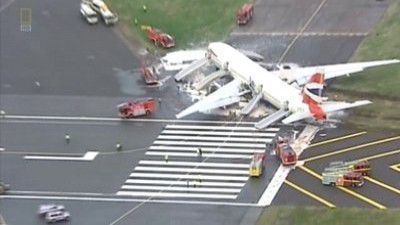
The plane passed above traffic on the A30 and the airport's Southern Perimeter road and landed on the grass approximately 270 metres (890 ft) short of runway 27L. The captain declared an emergency to the control tower a few seconds before landing.
During the impact and short ground roll, the nose gear collapsed, the right main gear separated from the aircraft penetrating the central fuel tank and cabin space, and the left main gear was pushed up through the wing. The aircraft came to rest on the threshold markings at the start of the runway. A significant amount of fuel leaked, but there was no fire. Four crew members and eight passengers received minor injuries, and one passenger received serious injuries (concussion and a broken leg).
Aftermath
The London Ambulance Service stated that three fast response cars, nine ambulances and several officers were sent to the scene to assess the casualties. Those injured were taken to the nearby Hillingdon Hospital.
Willie Walsh, the British Airways Chief Executive, released a statement praising the actions of the "flight and cabin crew [who] did a magnificent job and safely evacuated all of the 136 passengers. The captain of the aircraft is one of our most experienced and has been flying with us for nearly 20 years. Our crews are trained to deal with these situations". He also praised the fire, ambulance and police services.
All flights in and out of Heathrow were halted for a short time after the accident. When operations resumed, many long-haul outbound flights were either delayed or cancelled, and all short-haul flights were cancelled for the rest of the day. Some inbound flights were delayed, and 24 flights were diverted to Gatwick, Luton and Stansted. In an attempt to minimise further travel disruptions, Heathrow Airport received dispensation from the Department for Transport to operate some night flights. Even so, the following day (18 January) a total of 113 short-haul flights were cancelled due to crews and aircraft being out of position.
On the afternoon of 20 January 2008, two cranes lifted the aircraft onto wheeled platforms and removed it from its resting place. It was moved to the BA maintenance base and parked outside a British Airways hangar for further inspections. After assessment of damages and repair costs, the aircraft was written off.
During a press conference the day after the accident, Captain Peter Burkill said that he would not be publicly commenting on the cause of the incident while the Air Accident Investigation Branch (AAIB) investigation was in progress. He revealed that Senior First Officer John Coward was flying the aircraft, and that First Officer Conor Magenis was also present on the flight deck at the time of the accident. Coward was more forthcoming in a later interview, stating: "As the final approach started I became aware that there was no power ... suddenly there was nothing from any of the engines, and the plane started to glide."
Burkill and Coward were grounded for a month following the crash while they were assessed for posttraumatic stress disorder. Five months after the accident, Burkill flew again taking charge of a flight to Montreal, Canada. He remained "haunted" by the incident, and took voluntary redundancy from British Airways in August 2009. Burkill subsequently established a blog and wrote a book, "Thirty Seconds to Impact", that denounced BA's treatment of the situation following the crash. In November 2010 Burkill rejoined British Airways, stating "I am delighted that the discussions with British Airways, have come to a mutually, happy conclusion. In my opinion British Airways is the pinnacle of any pilot's career and it is my honour and privilege to be returning to an airline that I joined as a young man."
All sixteen crew were awarded the BA Safety Medal for their performance during the accident. The medal is British Airways' highest honour. On 11 December 2008 the crew received the President's Award from the Royal Aeronautical Society.
British Airways continues to use the flight 38 designation on its Beijing to London (Heathrow) route.
Initial speculations
Mechanical engine failure was not regarded as a likely cause given the very low probability of a simultaneous dual engine failure. An electronic or software glitch in the computerised engine-control systems was suggested as possible causes of the simultaneous loss of power on both engines. Both engine and computer problems were ruled out by the findings of the February Special Bulletin.
Speculation that radio interference from the Prime Minister's motorcade was responsible for the accident was also eliminated as a cause.
Initial analysis from David Learmount, a Flight International editor, was that "The aircraft had either a total or severe power loss and this occurred very late in the final approach because the pilot did not have time to tell air traffic control or passengers." Learmount went on to say that to land in just 350–400 metres (1,150–1,310 ft), the aircraft must have been near stalling when it touched down. The captain also reported the aircraft's stall warning system had sounded.
The METAR in force at the time indicated that the wind was forecast to gust according to ICAO criteria for wind reporting, but it was not gusting at the time and wind shear had not been reported. The possibility of a bird strike was raised, but there were no sightings or radar reports of birds. Speculation had focused on electronics and fuel supply issues. A few weeks after the accident, as suspicion started to fall on the possibility of ice in the fuel, United Airlines undertook a review of their procedures for testing and draining the fuel used in their aircraft, while American Airlines considered switching to a different type of jet fuel for polar flights.
Investigation
The Department for Transport's Air Accidents Investigation Branch (AAIB) investigated the accident, with the US National Transportation Safety Board (NTSB), Boeing and Rolls-Royce also participating. The investigation took two years to complete, and the AAIB published its final report on 9 February 2010. A number of preliminary reports and eighteen safety recommendations were issued during the course of the investigation.
The "black boxes", the flight data recorder (FDR) and cockpit voice recorder (CVR), along with the quick access recorder (QAR), were recovered from the aircraft within hours of the accident, and transported to the AAIB's Farnborough headquarters, some thirty miles from Heathrow. The information downloaded from these devices confirmed what the crew had already told the investigators, that the engines had not responded when the throttles were advanced during final approach.
Special Bulletin, 18 February 2008
A further update, issued on 18 February, stated that there was "no evidence of a mechanical defect or ingestion of birds or ice", that there was "no evidence of fuel contamination or unusual levels of water content" within the fuel and that the recorded data indicated that there were "no anomalies in the major aircraft systems". Some small foreign bodies, however, were detected in the fuel tanks, although it was later concluded that these had no bearing on the accident.
The report noted evidence that cavitation had taken place in both high pressure fuel pumps, which could be indicative of a restriction in the fuel supply or excessive aeration of the fuel, although the manufacturer assessed both pumps as still being able to deliver full fuel flow. The report noted the aircraft had flown through air that was unusually cold (but not exceptionally so), and concluded that the temperature had not been low enough to freeze the fuel. Tests were continuing in an attempt to replicate the damage seen in the fuel pumps and to match this to the data recorded on the flight. A comprehensive examination and analysis was to be conducted on the entire aircraft and engine fuel system, including modelling fuel flows, taking account of environmental and aerodynamic effects.
The report went on to note that the fire extinguisher handles had been manually deployed by the crew before the fuel shut-off switches. The fire extinguisher handles also have the effect of cutting off power to the fuel switches, meaning that the fuel may continue to flow – a potentially dangerous situation. The report restated a previous Boeing Service Bulletin giving procedural advice that fuel switches should be operated before fire handles. It went on: "This was not causal to the accident but could have had serious consequences in the event of a fire during the evacuation." Indeed, the need to issue Safety Recommendation 2008-009, affecting all 777 airframes which had yet to incorporate the Boeing Service Bulletin (SB 777-28-0025) – as was the case with G-YMMM – was given as the main reason for issuing this special bulletin, well before the accident investigation itself was complete.
Special Bulletin, 12 May 2008
The AAIB issued a further bulletin on 12 May 2008 which confirmed that the investigation continued to focus on fuel delivery. It stated that "The reduction in thrust on both engines was the result of a reduced fuel flow and all engine parameters after the thrust reduction were consistent with this." The report confirmed that the fuel was of good quality and had a freezing point below the coldest temperatures encountered, appearing to rule out fuel freezing as a cause. As in the aforementioned February bulletin, the report noted cavitation damage to the high-pressure fuel pumps of both engines, indicative of abnormally low pressure at the pump inlets. After ruling out fuel freezing or contamination, the investigation then focused on what caused the low pressure at the pump inlets. "Restrictions in the fuel system between the aircraft fuel tanks and each of the engine HP pumps, resulting in reduced fuel flows, is suspected." The fuel delivery system was being investigated at Boeing, and the engines at manufacturer Rolls Royce in Derby.
The Bulletin specifically ruled out certain other possible causes, stating: "There is no evidence of a wake vortex encounter, a bird strike or core engine icing. There is no evidence of any anomalous behaviour of any of the aircraft or engine systems that suggests electromagnetic interference."
Interim Report, 4 September 2008
The AAIB issued an interim report on 4 September. Offering a tentative conclusion, it stated:
The report summarised the extensive testing performed in an effort to replicate the problem suffered by G-YMMM. This included creating a mock-up of G-YMMM's fuel delivery system, to which water was added to study its freezing properties. After a battery of tests, the AAIB had not yet succeeded in reproducing the suspected icing behaviour, and was undertaking further investigation. Nevertheless, the AAIB believed its testing showed that fuel flow was restricted on G-YMMM and that frozen water in the jet fuel could have caused the restriction, ruling out alternative hypotheses such as a failure of the aircraft's FADEC (computerised engine control system). The hypothesis favoured in the report was that ice had accreted somewhere downstream of the boost pumps in the wing fuel tanks and upstream of the engine-mounted fuel pumps. Either enough ice had accumulated to cause a blockage at a single point, or ice throughout the fuel lines had become dislodged as fuel flow increased during the landing approach, and the dislodged ice had then formed a blockage somewhere downstream.
Because temperatures in flight had not dropped below the 777's designed operating parameters, the Air Accidents Investigations Branch (AAIB) recommended Boeing and Rolls-Royce take interim measures on Trent 800-powered 777s to reduce the risk of ice restricting fuel delivery. Boeing did so by revising the 777 operating procedures so as to reduce the opportunities for such blockages to occur, and by changing the procedure to be followed in the event of power loss to take into account the possibility that ice accumulation was the cause.
The report went on to recommend that the aviation regulators (FAA and EASA) should consider whether other aircraft types and other engines might be affected by the same problem, and to consider changing the certification process to ensure that future aircraft designs would not be susceptible to the newly recognised danger from ice formation in the fuel.
The report acknowledged that a redesign of the fuel system would not be practical in the near-term, and suggested two ways to lower the risk of recurrence. One was to use a fuel additive (FSII) that prevents water ice from forming down to −40 °C. Western air forces have used FSII for decades, and although it is not widely used in commercial aviation, it is nonetheless approved for the 777.
Final report, 9 February 2010
The AAIB issued a full report on 9 February 2010. It concluded:
The AAIB also studied the crashworthiness of the aircraft during the accident sequence. It observed that the main attachment point for the main landing gear (MLG) was the rear spar of the aircraft's wing; because this spar also formed the rear wall of the main fuel tanks, the crash landing caused the tanks to rupture. It was recommended that Boeing redesign the landing gear attachment to reduce the likelihood of fuel loss in similar circumstances.
Similar incidents
On 26 November 2008, Delta Air Lines Flight 18 from Shanghai to Atlanta experienced an "uncommanded rollback" of one engine while in cruise at 39,000 feet. The crew followed manual recovery procedures and the flight continued without incident. The US NTSB assigned one of the investigators who worked on the BA Flight 38 investigation to this incident, and looked specifically for any similarity between the two incidents. The NTSB Safety Recommendation report concluded that ice clogging the FOHE was the likely cause. The evidence was stronger in this case since data from the flight data recorder allowed the investigators to locate where the fuel flow was restricted.
In early 2009 Boeing sent an update to aircraft operators, linking the British Airways and Delta Air Lines "uncommanded rollback" incidents, and identifying the problem as specific to the Rolls-Royce engine fuel-oil heat exchangers. Originally, it was thought that other aircraft were not affected by the problem. However, in May 2009, another similar incident happened with an Airbus A330 powered by a Trent series 700 engine.
The enquiries led Boeing to reduce the recommended time that the fuel on 777 aircraft equipped with Rolls-Royce Trent 800-series engines be allowed to remain at temperatures below −10 degrees Celsius from three to two hours.
On 11 March 2009, the National Transportation Safety Board issued urgent safety recommendation SB-09-11 calling for the redesign of the fuel-oil heat exchangers used on Rolls-Royce Trent 800 Series engines. A build-up of ice from water naturally occurring in the fuel had caused a restriction of the flow of fuel to the engines of G-YMMM. Rolls-Royce had already started on redesigning the component, with an in-service date of March 2010 at the latest. All affected engines were to be fitted with the redesigned component within six months of its certification. In May 2010 the Airworthiness Directive was extended to cover the Trent 500 and 700 series engines as well.
Lawsuit
In November 2009 it was announced that 10 passengers were to sue Boeing for the incident in the Circuit Court of Cook County in Illinois, in the United States. It was reported that each of the ten plaintiffs could receive up to US$1,000,000 (about £600,000 at the time) compensation. The lawsuit alleged that the design of the aircraft was "defective and unreasonably dangerous", that Boeing "breached their duty of care" and also breached their "warranties of merchantability and fitness". Claims were settled out-of-court in 2012.
Dramatisation
The story of the incident was featured on the ninth season of Canadian TV series Mayday (also known as Air Emergency in the U.S. or Air Crash Investigation in the U.K. and other countries). The American title is named "The Heathrow Enigma", and the British name is "Heathrow Crash Landing"
